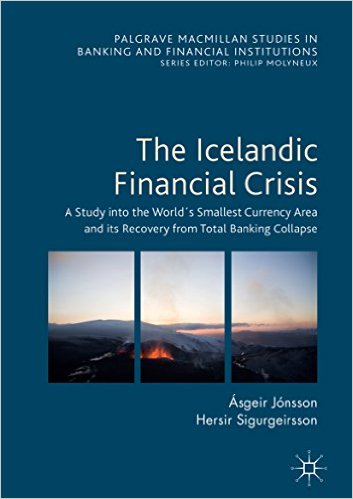Two experts on finance, Dr. Asgeir Jonsson, Associate Professor at the Faculty of Economics at the University of Iceland, and Dr. Hersir Sigurgeirsson, Associate Professor at the Faculty of Business Administration, have written a book on the aftermath of the 2008 Icelandic bank collapse, The Icelandic Financial Crisis: A Study Into the World’s Smallest Currency Area, published by Palgrave Macmillan in New York. A publication conference is to be held at the University of Iceland Wednesday 1 march 2017 at 16–18 in the Festitivites Hall, with talks by the two authors, followed by a panel discussion by Johannes Karl Sveinsson, legal adviser to government after the collapse, Jonas Fr. Jonsson, Director of the Icelandic Financial Supervisory Authority before the collapse, Dr. Sigurdur Hannesson, mathematician and adviser to government on lifting economic controls, and Kristrun Heimisdottir, former Assistant to the Foreign Minister, before and during the crisis. The conference is chaired by Professor Olafur Th. Hardarson.
 RNH draws attention to this publication conference and Jonsson’s and Sigurgeirsson’s informative book. The authors analyse the special circumstances in the collapse when the CBI, Central Bank of Iceland, could not provide the Icelandic banks with liquidity in other currencies, because it was almost everywhere denied currency exchange deals or credit lines. They also describe how the Parliament passed the Emergency Act 6 October 2008 to ensure that the banks’ collapse did not hit ordinary depositors too hard. Furthermore, they discuss the brutal reaction of the British Labour Government to the attempts of the Icelandic government to avoid national bankruptcy. Finally, the authors turn to the rapid recovery of the Icelandic economy, including deals with the creditors of the banks. They conclude that many lessons may be learned from this successful survival struggle of a small, open economy.
RNH draws attention to this publication conference and Jonsson’s and Sigurgeirsson’s informative book. The authors analyse the special circumstances in the collapse when the CBI, Central Bank of Iceland, could not provide the Icelandic banks with liquidity in other currencies, because it was almost everywhere denied currency exchange deals or credit lines. They also describe how the Parliament passed the Emergency Act 6 October 2008 to ensure that the banks’ collapse did not hit ordinary depositors too hard. Furthermore, they discuss the brutal reaction of the British Labour Government to the attempts of the Icelandic government to avoid national bankruptcy. Finally, the authors turn to the rapid recovery of the Icelandic economy, including deals with the creditors of the banks. They conclude that many lessons may be learned from this successful survival struggle of a small, open economy.



